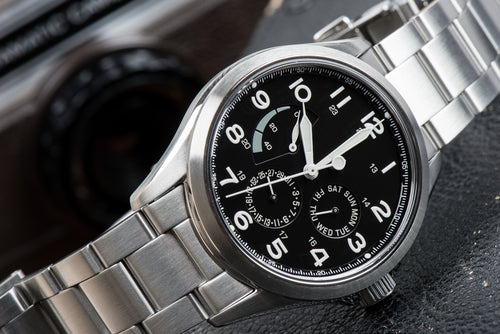Power reserve is a term commonly associated with mechanical watches. It refers to the amount of time a watch can run without being wound or worn. In other words, it is the length of time a watch can keep ticking after it has been fully wound.
Mechanical watches are powered by a wound spring that unwinds, motivating the hands, date, and other features of the watch. Once the spring is fully unwound, the watch stops running. The power reserve is the amount of time the watch can run before it needs to be wound again. This is determined by the amount of energy that can be stored in the mainspring.
Understanding power reserve is important for watch enthusiasts and collectors. It allows them to know when to wind their watch and keep it running smoothly. In addition, it is a useful feature for those who wear their watch infrequently or for those who have multiple watches in their collection. By knowing the power reserve of their watch, they can ensure that it is always ready to wear when they need it.
[product=premium-marlborough-polished-stainless-steel-watch-strap]
A superb watch bracelet to elevate any watch:
[/product]
Understanding Power Reserve in Watches
Defining Power Reserve
Power reserve refers to the amount of time a watch can continue to operate without being wound or moved. It is an essential feature of mechanical watches, which are powered by a wound spring. The power reserve is the amount of energy stored in the mainspring, which is the component that drives the watch's movement.
The Role of the Mainspring
The mainspring is the coiled spring that provides power to a mechanical watch. As the mainspring unwinds, it releases energy that drives the watch's movement. When the mainspring is fully wound, it provides the watch with its maximum power reserve. The power reserve decreases as the mainspring unwinds, until it eventually runs out of energy and the watch stops.
Mechanical vs. Automatic Watches
Mechanical watches are either manual-wind or self-winding (automatic). Manual-wind watches require the wearer to manually wind the mainspring to provide power to the watch. Self-winding watches, on the other hand, use the movement of the wearer's wrist to automatically wind the mainspring.
Automatic watches have a power reserve that is typically shorter than that of manual-wind watches, as the energy generated by the wearer's movement is not as consistent as that provided by manual winding. However, automatic watches are more convenient to use, as they do not require manual winding.
In summary, power reserve is a crucial feature of mechanical watches, and it is determined by the amount of energy stored in the mainspring. The mainspring is the component that drives the watch's movement, and it is wound either manually or automatically. The power reserve of a watch varies depending on the type of movement it has, with automatic watches having a shorter power reserve than manual-wind watches.
Components of Power Reserve
A watch's power reserve is determined by several components that work together to store and release energy. Understanding these components is essential to understanding how a watch's power reserve functions.
Barrels and Energy Storage
The barrel is the component that stores energy in a watch. It contains a spring that is wound up either manually or automatically, and as the spring unwinds, it releases energy to power the watch. Some watches have multiple barrels to increase their power reserve.
Power Reserve Indicator
A power reserve indicator is a feature that displays the amount of energy remaining in a watch's barrel. It is usually displayed through a small subsidiary dial or indicator hand, similar to a car fuel gauge. This feature is particularly useful for manual-wind watches, as it helps the wearer know when the watch needs to be wound.
The Winding Mechanism
The winding mechanism in a watch is responsible for transferring energy from the barrel to the watch's movement. In manual-wind watches, this is done by turning the crown, which winds the mainspring. In automatic watches, this is done by a rotor that spins as the wearer moves their wrist, which winds the mainspring. The winding mechanism is essential to the watch's power reserve, as it determines how much energy is transferred to the movement.
Overall, the components of a watch's power reserve work together to store and release energy, allowing the watch to function for a certain period without needing to be wound. Understanding these components is essential to understanding how a watch's power reserve functions.
Measuring and Indicating Power Reserve
Power reserve is the amount of time a watch can run without being wound or exposed to light. Measuring and indicating power reserve is an important function of mechanical watches, especially manual-winding and automatic watches. There are several ways to indicate power reserve on a watch, including dial indicators, fuel gauge analogy, and power reserve scales.
Dial Indicators
Dial indicators are the most common way to indicate power reserve on a watch. The power reserve complication is usually displayed on a subdial or a small window on the dial. An indicator hand shows the amount of remaining power reserve. The hand moves as the mainspring unwinds, indicating the remaining power reserve. Some watches have a power reserve indicator that displays the remaining power reserve in hours or days.
Fuel Gauge Analogy
The fuel gauge analogy is a popular way to indicate power reserve on a watch. Like a fuel gauge on a car dashboard, the power reserve indicator shows the remaining power reserve in a linear or circular scale. The scale is marked with different colors or numbers to indicate the remaining power reserve. The scale is usually located on the dial or a subdial.
Power Reserve Scales
Power reserve scales are another way to indicate power reserve on a watch. The scale is usually located on the back of the watch or on the movement. The scale is marked with different colors or numbers to indicate the remaining power reserve. The scale is usually calibrated in hours or days, depending on the watch.
In summary, measuring and indicating power reserve is an essential function of mechanical watches. Dial indicators, fuel gauge analogy, and power reserve scales are the most common ways to indicate power reserve on a watch. The choice of power reserve indicator depends on the design and function of the watch.
Notable Watches with Power Reserve Features
Luxury and Precision Timepieces
Luxury watches are known for their exquisite craftsmanship and precision, and many of them also feature impressive power reserve capabilities. One such example is the IWC Portugieser Automatic, which boasts a power reserve of up to 7 days. This watch is powered by the IWC-manufactured 52010 calibre movement, which features a Pellaton winding system and a Breguet spring. The result is a watch that is not only accurate but also has an impressive power reserve.
Another notable luxury watch with a power reserve feature is the Marine Chronometer by Ulysse Nardin. This watch is designed to withstand the rigors of the sea and features a power reserve indicator on the dial. The watch is powered by the UN-118 movement, which has a power reserve of up to 60 hours. The Marine Chronometer is also water-resistant up to 200 meters, making it a great choice for those who love water sports.
Innovations in Power Reserve Technology
Innovations in power reserve technology have led to watches with even longer power reserves. One such example is the Powermatic 80 by Tissot, which boasts a power reserve of up to 80 hours. The watch is powered by the Powermatic 80 movement, which features a silicon balance spring and a power reserve indicator on the dial.
Rado is another brand that has made significant strides in power reserve technology. The Rado Coupole Classic features a power reserve of up to 80 hours and is powered by the Rado Calibre R734. The watch also features a date display and a sapphire crystal case back.
For those looking for the ultimate in power reserve technology, the A. Lange & Söhne Lange 31 is the watch to beat. This watch boasts a power reserve of up to 31 days, thanks to its twin mainspring barrels. The watch is powered by the Lange L034.1 movement and features a power reserve indicator on the dial.
Other notable watches with power reserve features include the Oris Big Crown ProPilot Calibre 111, which boasts a power reserve of up to 10 days, and the Panerai Luminor GMT 10 Days, which features a power reserve indicator on the dial and a GMT function. These watches are a testament to the ingenuity and innovation of watchmakers, and they offer something truly special for those who appreciate fine timepieces.
Maintaining Optimal Power Reserve
To ensure that a watch functions properly, it is important to maintain its power reserve. There are several ways to do this, including regular winding, the use of a watch winder, and monitoring power reserve for accuracy.
The Importance of Regular Winding
Manual winding is an essential part of maintaining a watch's power reserve. The wound spring in a mechanical watch provides the energy needed to keep it running, and regular winding ensures that the spring is always fully charged. It is recommended that a watch be wound at the same time every day, preferably in the morning, to ensure that it maintains its power reserve.
Using a Watch Winder
For those who own multiple watches, a watch winder can be a useful tool for maintaining power reserve. A watch winder is a device that simulates the movement of the wrist, keeping the watch wound even when it is not being worn. This can be particularly useful for watches with longer power reserve times, as it ensures that they are always ready to wear.
Monitoring Power Reserve for Accuracy
One way to ensure that a watch is functioning properly is to monitor its power reserve. Most watches have a power reserve indicator that shows how much energy is left in the spring. It is important to pay attention to this indicator and wind the watch before the power reserve runs out. This not only ensures that the watch keeps accurate time but also prevents unnecessary wear and tear on the wound spring.
In summary, maintaining optimal power reserve is an important part of caring for a mechanical watch. Regular winding, the use of a watch winder, and monitoring power reserve for accuracy are all effective ways to ensure that a watch functions properly and keeps accurate time.











